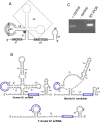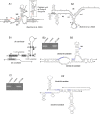Computational identification of four spliceosomal snRNAs from the deep-branching eukaryote Giardia intestinalis
- PMID: 18769729
- PMCID: PMC2518118
- DOI: 10.1371/journal.pone.0003106
Computational identification of four spliceosomal snRNAs from the deep-branching eukaryote Giardia intestinalis
Abstract
RNAs processing other RNAs is very general in eukaryotes, but is not clear to what extent it is ancestral to eukaryotes. Here we focus on pre-mRNA splicing, one of the most important RNA-processing mechanisms in eukaryotes. In most eukaryotes splicing is predominantly catalysed by the major spliceosome complex, which consists of five uridine-rich small nuclear RNAs (U-snRNAs) and over 200 proteins in humans. Three major spliceosomal introns have been found experimentally in Giardia; one Giardia U-snRNA (U5) and a number of spliceosomal proteins have also been identified. However, because of the low sequence similarity between the Giardia ncRNAs and those of other eukaryotes, the other U-snRNAs of Giardia had not been found. Using two computational methods, candidates for Giardia U1, U2, U4 and U6 snRNAs were identified in this study and shown by RT-PCR to be expressed. We found that identifying a U2 candidate helped identify U6 and U4 based on interactions between them. Secondary structural modelling of the Giardia U-snRNA candidates revealed typical features of eukaryotic U-snRNAs. We demonstrate a successful approach to combine computational and experimental methods to identify expected ncRNAs in a highly divergent protist genome. Our findings reinforce the conclusion that spliceosomal small-nuclear RNAs existed in the last common ancestor of eukaryotes.
Conflict of interest statement
Figures



Similar articles
-
Evolutionarily divergent spliceosomal snRNAs and a conserved non-coding RNA processing motif in Giardia lamblia.Nucleic Acids Res. 2012 Nov;40(21):10995-1008. doi: 10.1093/nar/gks887. Epub 2012 Sep 27. Nucleic Acids Res. 2012. PMID: 23019220 Free PMC article.
-
Spliceosomal snRNAs in the unicellular eukaryote Trichomonas vaginalis are structurally conserved but lack a 5'-cap structure.RNA. 2008 Aug;14(8):1617-31. doi: 10.1261/rna.1045408. Epub 2008 Jul 2. RNA. 2008. PMID: 18596255 Free PMC article.
-
Identification of the major spliceosomal RNAs in Dictyostelium discoideum reveals developmentally regulated U2 variants and polyadenylated snRNAs.Eukaryot Cell. 2006 Jun;5(6):924-34. doi: 10.1128/EC.00065-06. Eukaryot Cell. 2006. PMID: 16757740 Free PMC article.
-
Pseudouridines in spliceosomal snRNAs.Protein Cell. 2011 Sep;2(9):712-25. doi: 10.1007/s13238-011-1087-1. Epub 2011 Oct 6. Protein Cell. 2011. PMID: 21976061 Free PMC article. Review.
-
Structural features of U6 snRNA and dynamic interactions with other spliceosomal components leading to pre-mRNA splicing.Biochimie. 1996;78(6):436-42. doi: 10.1016/0300-9084(96)84750-x. Biochimie. 1996. PMID: 8915533 Review.
Cited by
-
Characterizing ncRNAs in Human Pathogenic Protists Using High-Throughput Sequencing Technology.Front Genet. 2011 Dec 27;2:96. doi: 10.3389/fgene.2011.00096. eCollection 2011. Front Genet. 2011. PMID: 22303390 Free PMC article.
-
High throughput genome-wide survey of small RNAs from the parasitic protists Giardia intestinalis and Trichomonas vaginalis.Genome Biol Evol. 2009 Jul 6;1:165-75. doi: 10.1093/gbe/evp017. Genome Biol Evol. 2009. PMID: 20333187 Free PMC article.
-
Characterization of RNase MRP RNA and novel snoRNAs from Giardia intestinalis and Trichomonas vaginalis.BMC Genomics. 2011 Nov 6;12:550. doi: 10.1186/1471-2164-12-550. BMC Genomics. 2011. PMID: 22053856 Free PMC article.
-
Sense-antisense gene overlap is probably a cause for retaining the few introns in Giardia genome and the implications.Biol Direct. 2018 Oct 17;13(1):23. doi: 10.1186/s13062-018-0226-5. Biol Direct. 2018. PMID: 30621773 Free PMC article.
-
The Integrator complex regulates differential snRNA processing and fate of adult stem cells in the highly regenerative planarian Schmidtea mediterranea.PLoS Genet. 2018 Dec 17;14(12):e1007828. doi: 10.1371/journal.pgen.1007828. eCollection 2018 Dec. PLoS Genet. 2018. PMID: 30557303 Free PMC article.
References
Publication types
MeSH terms
Substances
LinkOut - more resources
Full Text Sources

